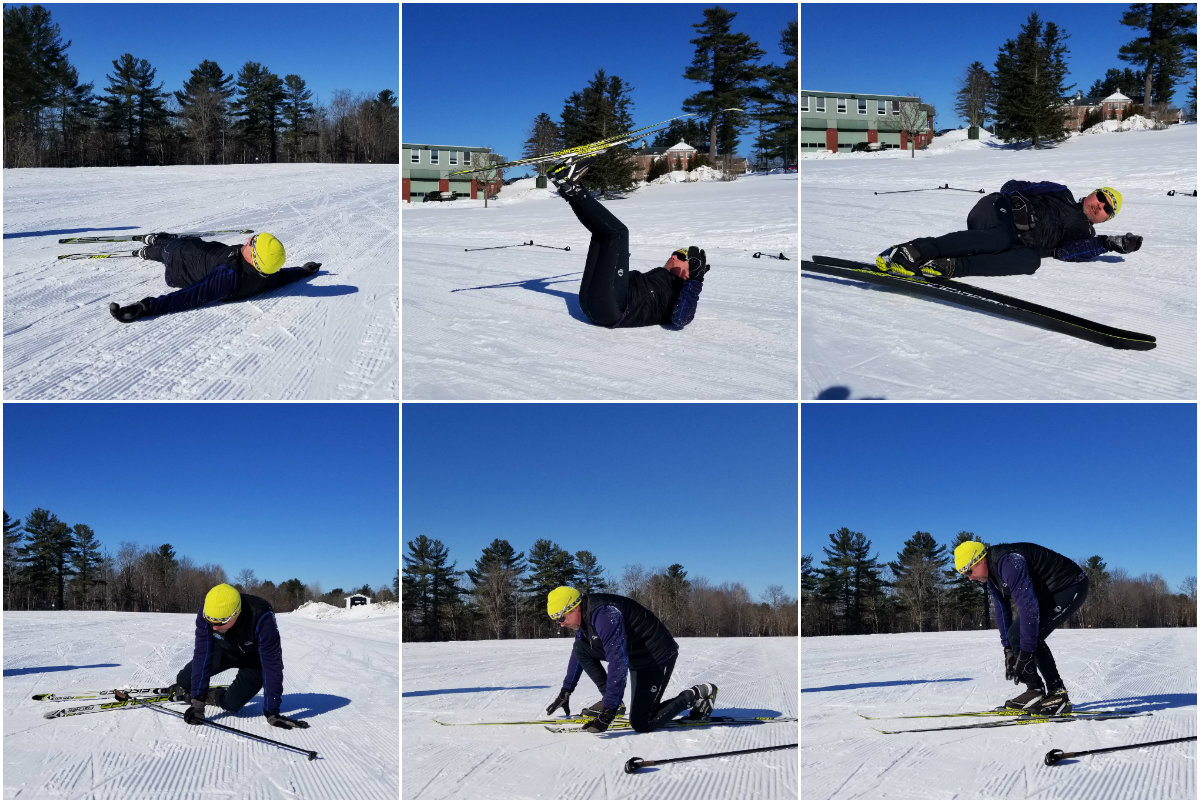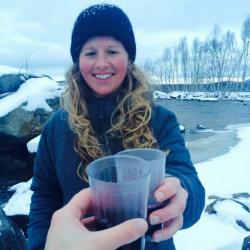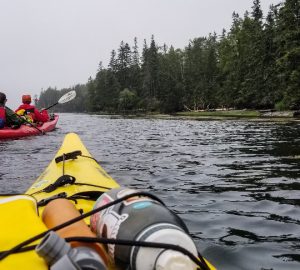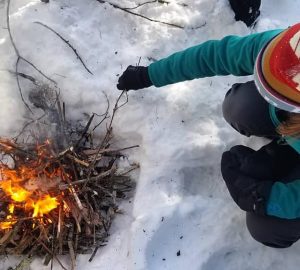Oh how I envy that skate-skier glide. That zipping speed. That stealth maneuvering. The way a skate skier sprints up a hill like some ambitious tights-wearing greyhound.
And then there’s me, timbering sideways on my skis like a felled tree and hitting the snow with a decidedly ungraceful grunt.
I’m less greyhound and more groundhog.
But like so many other wannabes, my skate-skier aspirations are strong. I’ve been a classic cross-country skier for years, sliding my skis in the parallel tracks like a rigid tin soldier. I really like the tracks. I do. But sometimes, I want to jump those tracks and tear down the trail, breezing past my classic-skiing compadres like a runaway train. Except, like, a totally safe and in-control runaway train. That’s a thing, right?
Anyway, I’m confident I CAN BE a skate skier. I just need in-person guidance, a couple hours of positive affirmations, and an instructor who’ll throw themselves on the ground at the start of class to make me feel better about the fact that I fall over all the time.
And I got all of that at a Learn to Skate Ski lesson with L.L.Bean.

L.L.Bean offers a range of clinics for the novice outdoorsperson through their Outdoor Discovery Program. In warmer months, you can get introduced to kayaking and paddleboarding, sporting clays, and archery. In the winter, try some snowshoeing, classic cross-country skiing, and – you guessed it – SKATE SKIING!
Just what I needed.

Snow sport clinics take place at Pineland Farms in New Gloucester, about a 15-minute drive from L.L.Bean’s flagship store in Freeport. The trails here are wonderful, whatever your experience level, and are groomed for classic and skate skiing.
If you were so inclined, you could come here, rent some skate skis from the Pineland Farms Outdoor Center, and hit the trails on your own. Figure it out as you go!
Except I don’t recommend that at all. And I speak from experience on this point. I thought I could watch a few “how to skate ski” videos on YouTube and learn all I needed to know. I spent an hour face planting. Maybe that was inevitable – skate skiing is a challenging sport to learn – but I suspect I’d have saved myself some frustration (and at least 50% of those face plants) if I’d started with a lesson.

The perks to taking a lesson – whether you’re trying something for the very first time or looking to advance your skills – are the tips you’ll glean from an experienced instructor. Often you can learn in a two-hour clinic what it might take you months to figure out on your own. Lovely things like, “Stop staring at your skis. Look up” and “No, your poles are not lances, please stop jabbing the air with them.”

Recently, I had the pleasure of taking a Learn to Skate Ski lesson with L.L.Bean’s Outdoor Discovery Program (and I didn’t inappropriately jab my poles at anyone, I promise).
The clinic begins in the Outdoor Discovery Program room – a lower-level space down a hallway in one of the brick buildings on the Pineland Farms campus. (It’s behind the Pineland Farms Outdoor Center and there are a few sandwich boards directing the way).

There we met Eric, our energetic and good-humored instructor, who walked us through some skate skiing basics – the shape of the ski (and the difference between skate skis and classic skis), what’s the deal with waxing, how long should our poles be, how do our boots clip into the skis – you know, the set-up stuff.
After we picked out our gear, and Eric made sure we were properly dressed, sunglassed, and sunscreened, we headed outside.

We dropped our skis onto the snow and stepped on – full of skier’s optimism. Eric showed us how to use our poles to help us balance as we tipped each toe into its binding.
Once our skis were on, there was a period of sudden immobility. Like we didn’t trust our feet or our balance at all, even though all of had experience with either classic skiing, downhill skiing, or both. It’s not like wearing skis was totally foreign. And yet. It felt a little foreign.

Slowly we started moving, leaning forward with our arms wide in typical “I might fall down at any moment” posture. Then our backs straightened, we relaxed, we started to get a feel for our skis.
Eric had us group up in a flat, open area so he could demonstrate some on-snow technique. First up: how to get up when you fall down.
This is one of the hardest bits to learn when you’re new to skiing. Eric’s tips: after you fall, reposition your legs so your skis are parallel on the snow. Maneuver your body over your skis. Move into “proposal position,” and then stand up. Also: don’t use your poles to pull yourself up and, if someone helps you up, make sure you’re pulling on them to get yourself up – not them yanking on you.

Eric showed us proper form – and how we needed to move our body weight from ski to ski. He demonstrated how to glide on one ski, then push off with the skis edge. He skied back and forth, slowly a few times and then in regular time, pointing out the bend in his knee, how his gaze fell on the horizon and not down on his ski tips (as beginners are prone to do), and how he kept his hands up and in front of him, rather than behind him (as beginners are sometimes prone to do).


Then it was time for us to give it a try.
I’ve been working on my glide, so off I went feeling fairly confident, but I noticed I was skiing on my inside edge the entire time – not planting my ski flat like you’re supposed to. I also stared down a lot, but Eric kept calling out, “look up!”
We all paced the open space, back and forth, trying to get accustomed to balancing on one ski, which is really hard to do and requires practice.
I’d push with my skis a few times, starting to get a feel for the movement, and then my body weight would veer off in the wrong direction or my leg would get nervous and wobbly, and I’d come to a flailing halt.


On the upside, it was a much better experience that those times I went out on my own after watching a few YouTube videos (which, for the record, I still think are great to watch as I continue learning). This time, it was awesome to have Eric watch us ski forward and back and offer tips for each of us.

Then, for the last 20 minutes of the session, Eric suggested we go for a short ski. Not just any short ski, a short ski with HILLS. Two in our group opted to ski that part and continue practicing their form on the flat practice area. The rest of us went for it.
As you can already tell from the photos, it happened to be a supremely pretty day (and also pretty frigid, but hey, that’s winter for you). So off we went on that scenic terrain, the trees casting long shadows on the trail as we chugged by.

On the hill, we went one by one, Eric reminding us that the “pizza” (ie, pointing the tips of your skis together and keeping the heels out, so your skis make a pizza or triangle shape) works to slow you down on all types of skis – skate skis included.
So we pizzaed our way down.

Going up the hill was harder – especially since not one of us has the sprinting-like-a-greyhound technique mastered yet. All that will come in time.

By the end of our class, we were all high on skate-skiing pride, feeling a little more prepared to hit the trails again now that we had some great foundational skills to start with.
Regular practice will be the thing that turns us into master skate skiers – and perhaps another lesson to hone our skills once we’ve got the basics down. And one day, we’ll be the ones charging gracefully by.
I can’t wait for that.

Intro to Skate Skiing
With L.L.Bean’s Outdoor Discovery Program
Pineland Farms, New Gloucester
Two-hour clinic, includes instruction and necessary gear (skis, boots, poles)
$45.95
FMI: www.llbean.com
Check out all the Outdoor Discovery Programs






